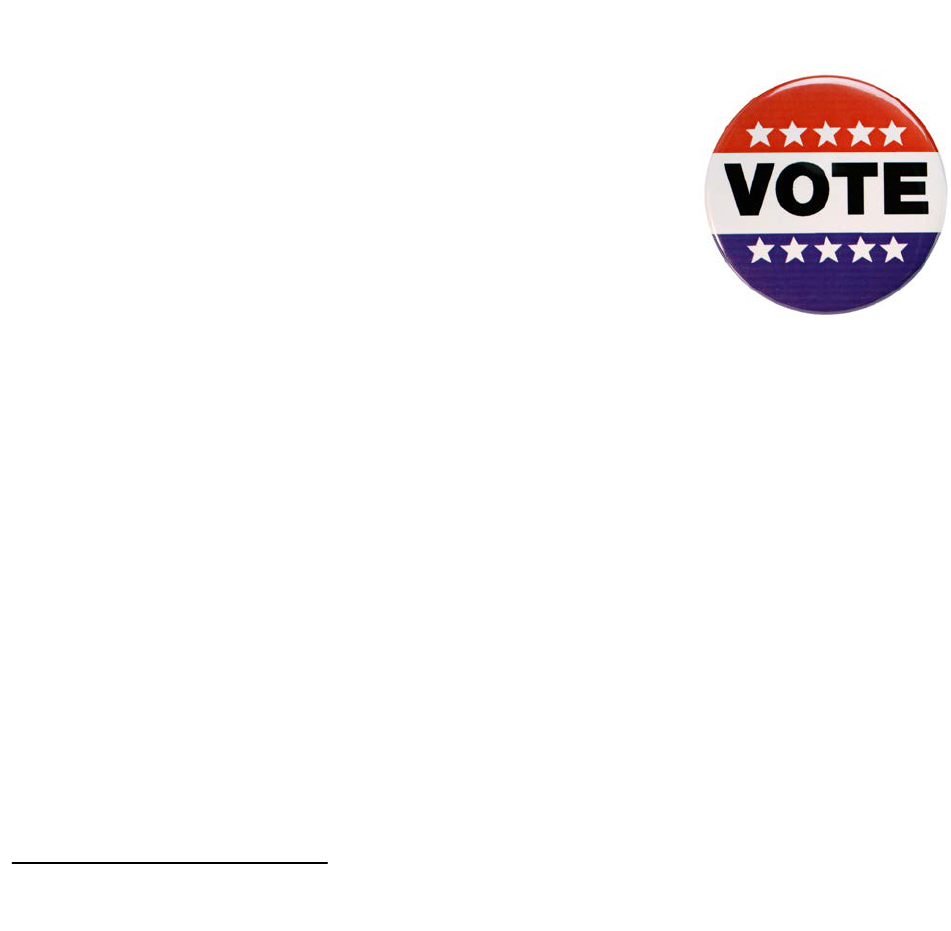
This guidance document is advisory in nature but is binding on an agency until amended by such agency. A guidance document does not
include internal procedural documents that only affect the internal operations of the agency and does not impose additional requirements or
penalties on regulated parties or include confidential information or rules and regulations made in accordance with the Administrative
Procedure Act. If you believe that this guidance document imposes additional requirements or penalties on regulated parties, you may
request a review of the document.
HOW TO USE
THE INITIATIVE AND
REFERENDUM PROCESS
IN NEBRASKA
SECRETARY OF STATE
JOHN GALE
This publication is provided free of charge and may be reproduced in part or in whole. This
pamphlet is intended for general informational purposes only and is not intended as a
substitute for statutory provisions.
Contributions to this publication from the Nebraska Accountability and Disclosure Commission
(Part III) and review and suggestions from individuals familiar with the initiative and
referendum process are greatly appreciated.
(Revised August 2015)

Dear Citizens of Nebraska,
The initiative and referendum process in Nebraska has a long and rich history. Established first
in 1912, the process has addressed a myriad of issues such as soldiers’ bonuses, bottle laws,
budget limitations and seat belts to name a few.
The power of the citizens to use this process is established within our state constitution. Many
suggest that it plays a more important role in Nebraska than other states because of our
unique unicameral legislature. It has been said that the people of Nebraska, through their use
of the initiative and referendum, comprise the second legislative house within our state.
With this power to create, amend, or repeal Nebraska’s statutes and constitution come some
responsibilities. It is hoped that the material in this pamphlet will provide basic information on
the rules and policies to use the initiative or referendum.
Sincerely,
John A. Gale
Secretary of State
TABLE OF CONTENTS
Foreword
PART I: The Petition Process
A. The Basics
B. The Step-by-Step Process
1. Filing the Petition
a. Initiative
b. Referendum
2. Circulating the Petition
a. The Circulators
b. The Signers
3. Submitting the Petition
PART II: Verification, Certification, and the Election
A. The Basics
1. What is the Verification Process?
2. What is the Certification Process?
B. The Step by Step Process
1. Verification of Signatures
2. Ballot Title and Language
3. The Election
a. Voter Education Pamphlet
b. Public Hearings
c. Publication of Text
d. The Election
e. After the Election
PART III: Other Matters
A. Accountability and Disclosure
B. Campaign Advertising Requirements
PART IV: Forms and Lists
A. Checklist
B. Do’s and Don’ts
This pamphlet is designed to provide basic information about the statewide initiative and
referendum process. There are other types of petitions that have a legal effect such as city
initiative and referendums, recall petitions, candidate or political party petitions and petitions
to form certain types of political subdivisions. More detailed information on statewide
initiative and referendum and other types of petitions can be obtained by contacting the
Secretary of State’s office or your local election official.
There are two major parts of the initiative and referendum process. The first part involves
gathering signatures on a petition. If enough signatures are submitted, the second part begins
which includes the verification of the signatures, placement of the issue on the ballot and the
election.

• What Is an Initiative or Referendum Petition?
Petitions can take many forms. In the broadest sense, even a letter to someone asking for some
type of action is a petition. More common is a list of several people signing a paper that expresses
their opinion. The right of citizens to petition their government is guaranteed by both the United
States and Nebraska constitutions.
An initiative or referendum petition is a specific type of petition that allows registered voters within
the state to place a question about state law or a state constitutional amendment on the ballot for
registered voters.
An initiative petition has two functions. One is to add or change a law for the entire state. The
second use is to amend the state constitution.
A referendum petition is used to repeal a law that the Legislature has recently passed.
• Who Can Use the Initiative and Referendum Process?
Any person, group, or association can use the process. However, only voters registered in Nebraska
may sign the petition. There are three groups involved in the process: the sponsors, the circulators,
and the signers.
The sponsors are the people who come up with the idea or reason to use the process. They are the
people who file the petition with the Secretary of State and distribute the petition to the
circulators. As mentioned, the sponsor can be a single person or a group of people.
The circulators are the people who take the petition around to get signatures. A circulator can
circulate the petition anywhere in the state.
The signers are the people who actually sign the petition. They must be registered to vote in
Nebraska.
What Issues Can be Addressed by the Petition?
PART I: The Petition Process
A. THE BASICS
• How Many Signatures Are Necessary?
As a result of a 1994 Nebraska Supreme Court decision, the
required number of signatures is based on the number of
registered voters at the filing deadline. For an initiative to propose
a law, signatures equaling 7% of the registered voters in the state
are required. For a constitutional amendment, 10% of the
registered voters must sign, and for a referendum, 5%. For a
referendum that suspends a law from taking effect, 10% of the
registered voters must sign the petition.
In addition, signatures must be collected from 5% of the registered
voters in 38 of the 93 Nebraska counties. This distribution
requirement applies to both initiative and referendum efforts.

The statewide initiative can be used to enact or amend a law or to amend the state constitution.
Generally, the initiative petition can address almost any issue. There is a statutory restriction on the
use of the initiative for issues that interfere with the legislature’s prerogative to raise the necessary
revenue for the state and its political subdivisions. In addition, the same measure may not be
placed on the ballot more often than once in three years. An initiative proposal may contain only
one subject.
The referendum petition is used only to repeal a law that the legislature passed during its most
recent session. The Nebraska constitution does not allow a referendum on appropriations matters.
• When Can the Process Be Used?
While the initiative process can begin at any time, there are deadlines that must be met. Initiative
petition signatures must be submitted to the Secretary of State no later than four months prior to
the general election. In addition, signatures on a petition become invalid at the first general
election occurring at least four months after the petition is first filed in the Secretary State’s office
(see Neb. Rev. Stat. §32-1407). Generally, this means that an initiative petition process can begin as
early as mid-July of an even numbered year and the signatures must be submitted by the first part
of July two years later.
The referendum process can begin when a law has been passed by the legislature and signed by the
Governor. The signatures must be submitted within 90 days after the legislature has adjourned.
B. THE STEP-BY-STEP PROCESS
This section will take you step by step through the petition portion of the process.
Once a sponsor has decided to begin an initiative petition effort, the first step is to deliver, to the
Secretary of State’s office, a copy of the language that they want to see in the statutes or in the
constitution and the object clause for the petition. The object clause is a brief statement of what
the proposal will accomplish. The sponsor also must provide a sworn list of the sponsors of the
petition at that time.
From there, the Secretary of State sends the language to the Revisor of Statutes, who reviews the
submitted language. The Revisor has 10 days to review the language and suggest changes to make
the language fit into the constitution or statutes clearly and uniformly. When the suggested
changes are returned to the Secretary of State, the sponsors are informed and may accept or reject
any suggestions made by the Revisor. The suggested changes are confidential for five days after
returned from the Revisor. The sponsor then provides the final language to the Secretary of State
and he or she places the language and object clause onto a petition form. The Secretary of State
provides 5 camera-ready copies of the form to the sponsor within 5 days. The form must contain a
statement in red and 16 pt. type that the petition is circulated by either a paid or volunteer
circulator. For examples of the form, see Appendix A.
1. Filing the Petition
a. Initiative

Once the final form is given to the sponsors, the language of the measure may not be changed or
amended. However, if a change in the language becomes necessary, sponsors must stop collecting
signatures on the petition and begin the process again with revised language.
b. Referendum
The procedures for filing a referendum petition are very similar to an initiative. Instead of
submitting the proposed initiative language, the sponsors submit a copy of the recently passed law
along with a statement of the object of the petition. The proposed referendum follows the same
path through the Revisor and Secretary of State as an initiative.
a. The Circulators
There are a few rules that the circulator of a statewide initiative or referendum must follow.
Circulators must be at least eighteen years of age. The circulator must witness each signature
added to the petition he or she is circulating. This means that a circulator may not leave the
petition at a location and return later when the petition is full. Each petition contains an oath that
the circulator signs stating that the circulator has read the object statement on the petition to each
signer of the petition.
There are few specific restrictions on where a circulator may gather signatures. There may be time
and place restrictions on public property so as not to disrupt activities at those locations.
Circulation on private property is at the discretion of the property owner. State law prohibits the
gathering of signatures within 200 feet of a polling place.
The circulator may not offer or give anything of value to a potential signer to get them to sign the
petition. It is a crime to do so, with a penalty of up to a year in jail and /or a $1000 fine.
A circulator may be paid to circulate a petition or may be a volunteer. If the circulator is being paid
to circulate the petition, he or she must use a form that discloses to the signer that the circulator is
being paid. If the circulator is a volunteer, the form must contain the volunteer disclosure. As
mentioned before, this disclosure must be in 16 pt. type and must be in red ink.
When the circulator is finished collecting signatures on the petition form, he or she must sign the
oath on the form. This oath must be signed in the presence of a notary public. The circulator should
read the oath carefully, as there are criminal penalties for falsely swearing to the oath.
Once the petition form is completed, the petition form should be returned to the sponsors of the
petition. While the Secretary of State will accept the completed petition and forward it to the
sponsors, it is preferable that the petition be returned directly to the sponsors.
2. Circulating the Petition
Once the sponsors have received the camera-
ready copies of the form, they may print or copy
the form and begin collecting signatures from
registered voters in the state.

b. The Signers
As with the circulator, there are a few rules that the signer must follow.
While the signer does not have to be a registered voter at the time he or she signs the petition, he
or she must be a registered voter by the deadline for the submission of the petition. By signing the
petition, the signer is stating that he or she is a registered voter or will be by the submission
deadline.
There are three rules that a signer must not violate. A signer may not sign any name other than his
or her own to a petition. A signer may not sign a petition more than once. The signer may not
accept anything of value for signing the petition.
The information provided by the signer is checked by local election officials to determine whether
the signer is a registered voter. It is easier for the local official to verify the signature if the signer
signs the petition the same way they are registered. There will be situations where the signer is
unaware of how they are registered and may use a nickname or other variation. Local officials will
make every attempt to verify the signature despite the difference. Common nicknames such as
“Bob” for “Robert” will be counted by the local officials. More detail on this process is described in
the section on verification.
Occasionally a signer will make mistakes as they sign the petition. It is permissible to cross out the
incorrect signature line without affecting the other signatures on the petition.
3. Submitting the Petition
Once the signatures are collected, the sponsors will submit the petitions to the Secretary of State.
The signatures must be submitted no less than four months prior to the general election. The
submitted petitions should be separated by county. The Secretary of State will make sure there are
at least the minimum number of signatures required prior to sending the petitions to local officials
for verification. Assuming there are enough signatures, the petitions will be numbered and
forwarded to the local election officials.

A. The Basics
1. What Is the Verification Process?
The verification process is conducted after the signatures are submitted to the Secretary of State.
Its purpose is to ensure that enough Nebraska voters have signed the petition to meet the
constitutional requirements and to prevent potential fraud in the process. Each signature is
compared with the voter registration records.
2. What Is the Certification Process?
The certification process includes the totaling of all valid signatures from the 93 counties and
addressing any remaining situations to ensure that all valid signatures are counted. Also, during the
verification and certification process, the Attorney General prepares the ballot title for the
measure. If enough signatures are verified to meet the constitutional standards, the measure is
formally certified by the Secretary of State to be placed on general election ballot.
Upon receiving the petitions from the Secretary of State, the local official will begin comparing the
information on the petition with the voter registration records.
The first check will be on the circulator of the petition. The local official will check the circulator’s
oath to ensure it is complete, including the required notarization. If the circulator provision is
invalid, no signatures on the petition sheet will be verified or counted.
If the circulator portion is valid, the local official will next check the signer’s information. They will
compare the information on the petition sheet with the voter registration record to make sure that
the voter is registered and that they have not signed the petition more than once. The local official
will compare the printed name, address, birthdate, and signature with the information on file.
If the signer is found to be a registered voter, the petition sheet is marked and the signature
counted. If the signer had signed more than once, only the first signature is not counted. If the
signer is not found to be a registered voter or for other reason invalidated, the reason for the
invalidation (by page and line number) is noted. The local official’s decision may be changed if
additional evidence is provided to the local election official.
Local officials must return the verified petitions within 40 days after receiving them from the
Secretary of State, although an additional 10 days may be granted in unusual circumstances. The
Secretary of State will review the petitions and total the number of valid signatures. If there are
sufficient valid signatures, the Secretary of State will certify the measure for the general election
ballot.
PART II: Verification, Certification, and the Election
B. The Step-by-Step Process
1. Verification of Signatures

3. The Election Period and Beyond
The election on initiative and referenda takes place at the statewide general election which occurs
on the first Tuesday following the first Monday in November in even-numbered years. Prior to the
election, there are three informational mechanisms used by the Secretary of State:
b. Public Hearings
b. Public Hearings
Second, the Secretary of State conducts public hearings on the measures with a public hearing in
each congressional district. These hearings occur no more than 8 weeks prior to the general
election. Proponents and opponents are encouraged to attend to provide their views on the
measure.
c. Publication of Text
The final information source is the publication of the entire text in all legal newspapers in the state
once each week for the three weeks prior to the election.
2. Ballot Title and Language
When the petition is submitted for verification, the Secretary of
State will deliver a copy of the measure to the Attorney General.
The Attorney General will write a ballot question or title that
summarizes (in 100 words or less) the purpose of the measure.
In addition, the Attorney General will provide material that
explains the effect of a vote for or against the measure. These
items will appear on the ballot.
If anyone believes that the ballot language is not sufficient or
fair, they may file in district court, asking for the language to be
changed. This must be filed within 10 days after the language is
delivered to the Secretary of State.
The final language (either from the Attorney General or the
district court) is sent by the Secretary of State to each local
official for placement on the ballot. The language on the ballot
will indicate that the voter is to vote either “For” or “Against” an
initiative measure and “Repeal” or “Retain” on a referendum.
a. Voter Information Pamphlet
The first is the publication of a pamphlet that contains the ballot title and arguments for and
against the measure. The pamphlet is available from local election officials and is available at
least six weeks prior to the election. Proponents and opponents of the measure may submit
suggestions on material to be included in the pamphlet. It should be noted, however, that the
pamphlet is written and produced by the Secretary of State and any submitted material may or
may not be used at his or her discretion.

e. After the Election
After election day, the votes on an initiative or referenda are counted in the same manner as any
other ballot. Two days after the election, the local canvassing board will meet to certify results from
the county level. Those results are forwarded to the Secretary of State and are presented to the
State Canvassing Board, which consists of the Governor, Attorney General, Auditor, Treasurer, and
the Secretary of State. The State Canvassing Board certifies the statewide vote totals on the
measure on the fourth Monday following the general election. Within 10 days after certification by
the canvassing board, the Governor issues a proclamation declaring which measures have passed
and are effective as of that time.
Persons involved in a statewide initiative or referendum process are subject to the provisions of the
Nebraska Political Accountability and Disclosure Act (§§49-1401, et seq., Neb. Rev. Stat.). This act
defines a ballot question as any question which is submitted or which is intended to be submitted to a
popular vote at an election, including an initiative and a referendum.
Persons supporting or opposing statewide initiative or referendum processes must keep records of
contributions received and expenditures made in connection with the petition effort and, in the event
the question is placed on the ballot, contributions received and expenditures made in connection with
supporting or opposing the passage or defeat of the ballot question.
Persons raising, receiving or exceeding more than $5,000 in a single calendar year for the purpose of
supporting or opposing the qualification, passage or defeat of a ballot question must register as a
ballot question committee. Within ten days after exceeding the $5,000, a Statement
of Organization
must be filed with the Nebraska Accountability and Disclosure Commission (NADC Form A-1).
d. The Election
The vote on statewide initiatives and referenda takes place at
the general election in November in even-numbered years. At
that time, all voters in the state are able to cast ballots for
certified ballot measures. For a measure to pass, not only do
more people have to vote for the measure than against, but also
at least 35% of voters casting ballots must vote for the measure.
For example, 100 people show up at the polls to vote. Of those
100 voters, not only must there be more votes cast “For” (or
“Repeal”) than “Against” (or “Retain”), but at least 35 must vote
“For” the initiative (or “Repeal” for referenda) for the measure to
be successful.
Another constitutional provision addresses the situation where
two initiatives conflict. If two or more initiatives conflict and they
both (or more) pass, the measure receiving the most votes “For”
will be adopted as to those provisions that conflict.
PART III: Other Matters
A. Accountability and Disclosure

A ballot question committee is required to file Campaign Statements (NADC Form B-1), disclosing the
committee's receipts and expenditures. Campaign Statements must be filed with the Nebraska
Accountability and Disclosure Commission according to the following schedule:
• On the last day of the calendar month in which the petition is filed with the Secretary of
State
• On the last day of each month after the month in which the petition is filed with the
Secretary of State
• On the 30th day after the deadline for filing the signed petitions with the Secretary of
State
If the issue is placed on the ballot for a vote at an election, the committee must also file Election
Campaign Statements in connection with the election in which the issue is voted upon. Election
Campaign Statements must be filed with the Nebraska Accountability and Disclosure Commission
according to the following schedule:
• On or before the 30th day prior to the election in which the issue is voted upon
• On or before the 10th day prior to the election in which the issue is voted upon
• On or before the 70th day following the election in which the issue is voted upon
B. Campaign Advertising Requirements
Printed materials having reference to the ballot issue must contain the name and street address of the
person or committee paying for the matter. If the person paying for the matter acts at the direction
of, or receives reimbursement from, a ballot question committee, the committee is considered the
"person" paying for the matter. Television and radio advertisements must also include the name of
the person or committee who paid for the ads, but such person's or committee's street address need
not be included in the ad if the station running the ad will agree to keep the person's or committee's
name and street address on file and available to the public for 6 months after the advertisement is
run.
One or more persons using their own personal resources who do not raise or spend more than the
$5,000 threshold requiring formation of a committee are exempt from the requirement to identify
advertising pertaining to the ballot issue.
For reporting forms and further information, contact the Nebraska Accountability and Disclosure
Commission, 11th Floor, State Capitol Building, P. O. Box 95086, Lincoln, NE 68509 or call (402) 471-
2522, or visit their website: http://nadc.nol.org.

Before Filing with Secretary of State
Develop language for statute or constitutional amendment
Review Accountability and Disclosure requirements
At Time of Filing with Secretary of State
Provide copy of proposed language and object clause
Provide list of sponsors
After Review by Revisor
Review suggestions and approve final petition language
Print petition provided by Secretary of State
Circulation
Each petition sheet should contain signatures from one county only. Use separate sheets for
different counties.
Review and train circulators on signer and circulator requirements
Comply with applicable Accountability and Disclosure requirements
Submitting the Signatures
Petitions submitted no later than 5:00 PM at least 4 months prior to the general election
Monitor verification process
Review ballot question and title when submitted by Attorney General
After Certification of Measure for Ballot
Submit suggestions for informational pamphlet
Attend public hearings on measure
PART IV: FORMS & LISTS
A. Check List

B. DO’S and DON’TS
Have signers sign the petition as closely as possible to how they are registered. This aids in
the verification process.
Have circulators completely fill out the circulator portion of the petition.
Make sure the circulator portion is notarized.
If a signer makes a mistake on one line, cross it out and complete the next line.
Have signers write as legibly as possible. This also helps with verification.
Have signers from more than one county sign a petition sheet.
Leave a petition at a location and pick it up later. A circulator must witness each signature
on a sheet they are circulating.
Do
Don’t
